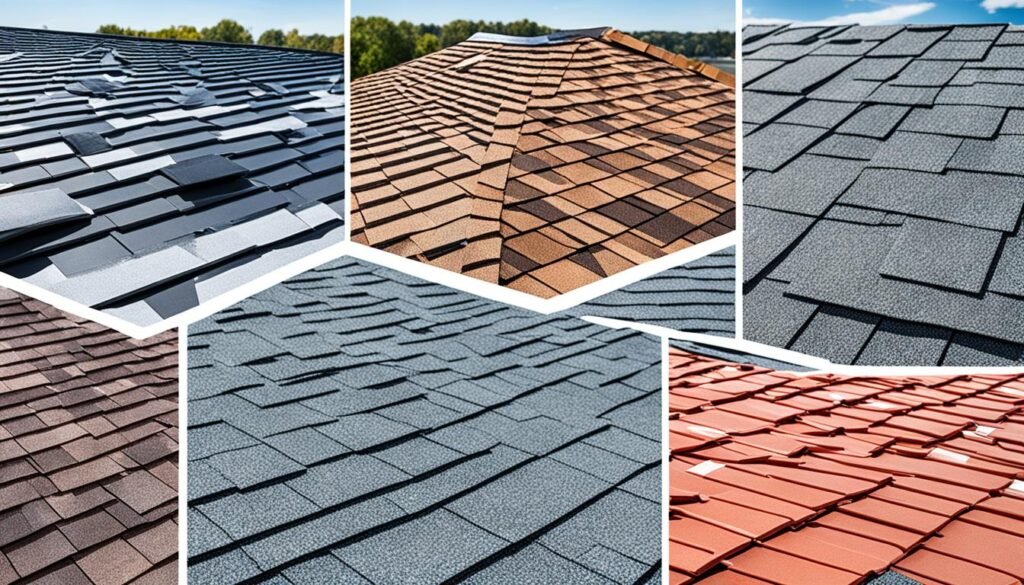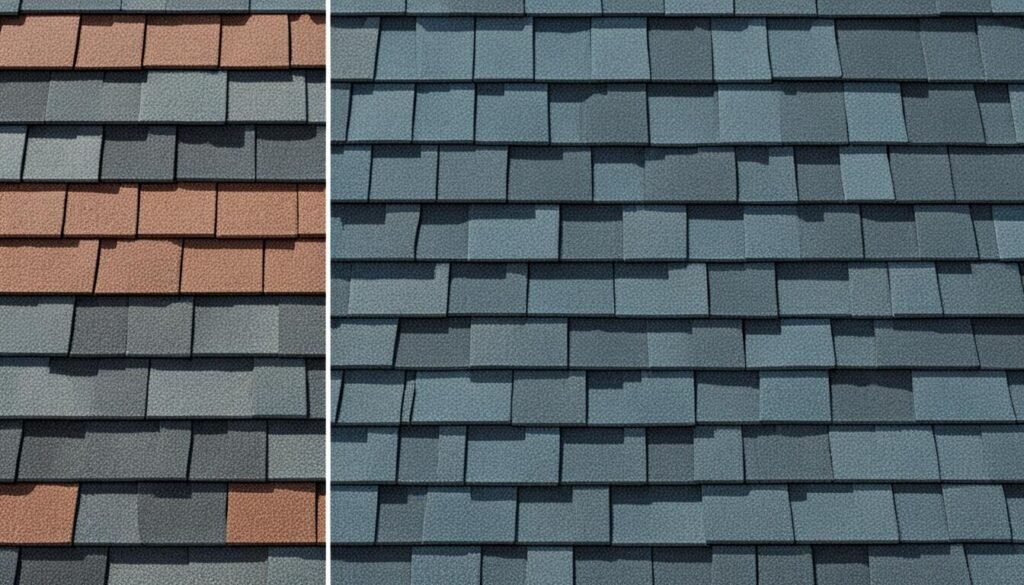Did you know that there are roofing materials available today that can last up to 100 years? That’s right, these durable options provide a century-long lifespan, making them the ideal choice for homeowners looking for permanent roofing solutions. In this article, we will reveal the top long-lasting roof types that offer superior longevity, giving you peace of mind and long-term value for your investment.
Key Takeaways:
- Concrete, clay, and slate tiles have an average lifespan of 100 or more years, making them the longest-lasting roof types.
- Wood shakes and metal roofs are gaining popularity due to their durability and lower cost.
- Synthetic shingles offer impressive durability and aesthetics at a lower price than natural slate roofing.
- When choosing a roofing material, consider factors such as longevity, cost, required maintenance, repair costs, and aesthetics.
- Investing in a quality roof and ensuring proper maintenance can maximize its lifespan and increase home value.
Factors to Consider When Choosing a Roofing Material
When it comes to selecting the right roofing material for your home, there are several essential factors to consider. Each factor plays a crucial role in ensuring you make an informed decision that suits your needs and preferences. Take a look at the key considerations below:
Longevity
The lifespan of the roofing material is an important factor to consider. You want a roof that will stand the test of time and provide lasting protection for your home. By choosing a material with a longer lifespan, you can avoid the hassle and expense of frequent roof replacements in the future.
Cost and ROI
Cost is often a significant deciding factor for homeowners. It’s important to find a roofing material that fits within your budget while also providing a good return on investment (ROI). Consider the upfront cost of the material, as well as its long-term value, durability, and potential energy savings.
Required Roof Maintenance
Maintaining your roof is crucial for its longevity and performance. Different roofing materials may require varying levels of maintenance. Consider your willingness to invest time and effort into regular roof maintenance when choosing a material. Some materials may require more frequent inspections, cleaning, and repairs.
Roof Repair Costs
Roof repairs are inevitable over the lifespan of your roof. Before making a decision, consider the potential repair costs associated with different roofing materials. Some materials may require more extensive repairs and higher costs, while others may offer more affordable repair options.
Aesthetics
The appearance of your roof plays a significant role in enhancing the overall curb appeal of your home. Choose a roofing material that complements the architectural style of your house and works well with your siding and other exterior elements. A visually appealing roof can greatly enhance the aesthetic value of your property.
Considering these factors will help you make an informed decision and choose a roofing material that meets your specific needs. Keep in mind that consulting with a professional roofing contractor like Local Roofer Pros can provide valuable insights and guidance based on their expertise and experience.
Now, let’s take a closer look at the lifespans of different roofing materials in the next section.

Source:
Local Roofer Pros
Roofing Materials and Their Lifespans
When it comes to choosing the right roofing material, one important factor to consider is its lifespan. Different roofing materials have varying lifespans, which can greatly impact the longevity and durability of your roof. In this section, we will explore the lifespans of various roofing materials commonly used for both commercial and residential roofs.
Commercial Roofs
For commercial roofs, there are several options available, each with its own lifespan. Green roofs, which are covered with vegetation, typically have a lifespan of 30 years or more. Thermoplastic Olefin (TPO) roofs and Ethylene Propylene Diene Monomer (EPDM) roofs offer a lifespan of 20 to 30 years. Modified bitumen roofs, commonly referred to as mod bit roofs, have a lifespan of 15 to 20 years. Built-up roofs (BUR) made of multiple layers have a lifespan of 10 to 30 years depending on the materials used.
Residential Roofs
When it comes to residential roofs, there is a wider variety of materials to choose from, each with its own unique lifespan. Let’s take a closer look:
- Asphalt shingles (3-tab): These are the most common and affordable roofing option for residential homes. They typically have a lifespan of 15 to 25 years.
- Asphalt shingles (architectural): Compared to 3-tab asphalt shingles, architectural shingles offer better durability and aesthetic appeal. They have a lifespan of 25 to 30 years.
- Wood shingles: Wood shingles provide a natural, rustic look to a home. They typically last around 30 years with proper maintenance and care.
- Metal roof: Metal roofs are known for their longevity and durability. They can last anywhere from 40 to 80 years depending on the type of metal used, such as aluminum or steel.
- Copper panels: Copper roofs are a premium option, known for their elegance and longevity. They have a lifespan of 70 years or more.
- Synthetic slate: Synthetic slate roofing provides the look of natural slate at a lower cost. It can last between 50 to 60 years.
- Slate: Natural slate roofs are incredibly durable and can last over 100 years with proper installation and maintenance.
- Clay tiles: Clay tiles offer a distinctive look and have a lifespan of 50 to 100 years.
- Concrete tiles: Concrete tiles are known for their durability and can last over 50 years.
Choosing the right roofing material for your needs involves considering factors such as cost, durability, and aesthetics. Keep in mind that regular maintenance and proper installation also play a significant role in prolonging the lifespan of your roof.
Now that we’ve explored the lifespans of different roofing materials, let’s move on to the conclusion to summarize what we’ve learned so far.

| Roofing Material | Lifespan |
|---|---|
| Asphalt shingles (3-tab) | 15 to 25 years |
| Asphalt shingles (architectural) | 25 to 30 years |
| Wood shingles | Around 30 years |
| Metal roof | 40 to 80 years |
| Copper panels | 70 years or more |
| Synthetic slate | 50 to 60 years |
| Slate | Over 100 years |
| Clay tiles | 50 to 100 years |
| Concrete tiles | Over 50 years |
Conclusion
Choosing the right roofing material is crucial when considering longevity and durability. Clay, concrete, and slate tiles offer the longest lifespan, surpassing 100 years. In addition, wood shakes and metal roofs are gaining popularity for their durability and aesthetic appeal. When deciding on the best roofing material for your home, it’s essential to balance cost and longevity, taking into account factors such as required maintenance and repair costs.
Proper maintenance plays a vital role in maximizing the lifespan of your roof. Regular inspections, cleaning, and timely repairs can prevent potential issues and extend the longevity of your chosen roofing material. By investing in a quality roof and following the proper maintenance guidelines, you can enjoy the long-term benefits of a durable roofing system.
Professional installation is a key component in ensuring the longevity and performance of your roof. Trusting reputable companies, such as Local Roofer Pros, who specialize in professional roofing installation, guarantees long-lasting protection for your home. Their expertise ensures that your roof is installed correctly, providing superior durability and increasing the value of your property.
FAQ
What are the longest-lasting roof types available?
The longest-lasting roof types include concrete tiles, clay tiles, and slate roofing, which can last 100 years or more. Wood shakes and metal roofs are also durable options with lifespans of 30 years or more.
What factors should I consider when choosing a roofing material?
When selecting a roofing material, it’s important to consider longevity, cost, return on investment (ROI), required maintenance, repair costs, and aesthetics.
What is the lifespan of different roofing materials?
Commercial roofs, such as green roofs, TPO, EPDM, modified bitumen, and BUR, typically last from 5 to 30 years. Residential roofs have longer lifespans with asphalt shingles lasting 15 to 30 years, wood shingles lasting 30 years, metal roofs lasting 40 to 80 years, and copper panels lasting 70 years or more. Concrete tiles, clay tiles, slate, and synthetic slate have lifespans of 50 to over 100 years.
How do I choose the right roofing material?
When choosing a roofing material, consider factors like longevity, cost, required maintenance, repair costs, and aesthetics. Assess your priorities and budget to make an informed decision on the best roofing material for your needs.
What are the benefits of durable roofing materials?
Durable roofing materials provide long-lasting protection for your home, reducing the need for frequent repairs or replacement. They also increase the value of your home and enhance curb appeal.
Should I hire a professional for roof installation?
Professional installation by companies like Local Roofer Pros ensures that your roof is properly installed, maximizing its lifespan and preventing potential issues. A reputable roofer can also provide advice on choosing the right roofing material for your specific needs.
